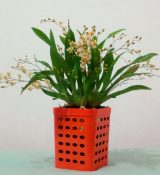Orchids Propagation Overview
Author: admin4 Comments
Orchid Plant and Flower Propagation Information Overview
There are many ways in which orchids are propagated today, commercial nurseries will use mass production methods to reproduce a choice variety of either a specie or hybrid plant, the favoured one goes by the name of meristem culture, this laboratory technique involves the mass tissue culture of the growing meristem tip from within the new growth of the plant concerned, the nucleus of cells derived from this small sample of tissue or grown on in flasks on nutrient gels. The result of this is the successful production of any number of plants, all identical to the original more or less, and that is how excellent plants become available to us all at remarkably low prices.
However in nature initial fertilization of the orchid flower must take place for the seed pod to develop, and if a new hybrid or selective breeding is used to satisfy our demand for a new or improved variety then its back to nature for the hobbyist and commercial grower alike, so this article will focus on the principle of natural fertilization and propagation.
An insect when pollinating a flower usually does so by collecting the pollen sacks from one plant (a forced occupation as the pollen plant by various clever means deliberately sticks the pollen sacks to the insect as it leaves) and depositing them on the stigmatic surface of its next orchid flower as it strives to collect its reward of a little nectar.
Man can do the same thing, usually with the aid of a toothpick and the two pollen sacks seen on the left are about to be deposited onto the stigmatic surface of the pod parent plant where they will adhere, and the minute pollen grains will embed themselves into the sticky bed and nature will begin to take its course.
In a few days, providing the seed was viable, the flower will shrivel and the column will swell to enclose the pollen saturated area, the stem of the flower will begin to swell and a seed pod will develop
This seed pod may remain on the plant for several months until it is ripe, it is important that the pod is harvested before it splits as the seed may be lost or spoiled.
Not all seed pods will have viable seed, and in order to ensure that no more time is wasted on them a sample of seed will be examined, they are so minute that a microscope is needed to see them properly even after they have been soaked for a few hours in a sugar water solution, which makes them easier to study. On the right, you can see how primitive an orchid seed really is, it consist of a single cell, which is contained within an open a fibrous network, and at this stage is extremely underdeveloped.
In nature, the orchid seed will only grow when exposed to a microscopic fungus, which helps to break down the sugars and nutrients for the seed: the seed cannot survive without this symbiosis taking place, but as it is a hit and miss affair in propagation in the hands of man an alternative and more viable method has been evolved.
Firstly, as the orchid seed which has been contained in a sterile atmosphere within its seed pod may be contaminated by the wrong airborne fungal spores, and as it is about to be introduced to another sterile container ( a flask) it must be thoroughly sterilized to avoid being contaminated within its new environment.
A nutrient gel is prepared and sterilized also, this will eliminate the need of the primitive seeds dependence on symbiosis. The gel is allowed to set inside the flask, and the sterilized orchid seed is sown thinly across its surface. Hopefully the seed sowing will have been successful and in a little time will germinate, and the surface of the gel will become covered with a mass of round green spheres, these are called protocorms.
These miniature orchids will be sown again into new flasks which may contain a stronger medium, and again this is done in sterile conditions, eventually from the thousands of protocorms originally sown only around 25/30 will be sown into the final flask.
The task of replating (reflasking) may be done again and again as the plantlets mature and grow, and eventually they will become large enough to be pricked out and sown in regular orchid compost to continue and grow into flowering plants.
From seed to mature plant can take from three years upwards.
Orchids may be propagated by division, those whose growths are Sympodial, (that is one new growth appearing from the base of an older growth) lend themselves easily to such an exercise, taking a sterile blade, cut through the rhizome leaving ideally at least three growths on each portion, this can be done at any time, providing the plant remains undisturbed in its original compost until the next re-potting takes place, when you should have perfect divisions.
On Monopodial orchids (those whose new growth comes from the centre of the plant, the exercise is a little more complicated, and should not be undertaken lightly. Vandaceous orchids are of this type, and when a plant has reached a size too big for you to cope with, it may be cut down, providing that there are sufficient aerial roots on the cutting to make it viable, which can then be re basketed to grow on, the old stump should not be thrown away, as it may well produce several new growths from below the cut, and these may be eventually removed to form new plants or left as a splendid clump.
Phalaenopsis orchids if damaged may produce several new growths from beneath the ruined crown, or a little keiki paste may be added to the nodes of a flowering spike to encourage the growth of plantlets, sometimes this happens without encouragement, and when the plantlets have enough root they may be teased from the parent and potted up.
4 Responses to “Orchids Propagation Overview”
Leave a Reply


Ask an Expert
Questions about orchids?
Our experts love a challenge!
Photo of the Week
Submit your photo to be featured on the blog!
More Photo of the Week Winners
Submit Photo








I have a dozen Orchids that my cousin brought from Japan about 2 weeks ago. Three of them have “pods” on them. Since thay are already cut, is there a way for me to grow them from these stems? I know NOTHING about Orchid, just that they are SO beautiful and my favorite flower! Can you help me out? gisele
It’s actually possible to grow any plant from a few cells of another, but this takes much skill. Most orchids take special care to propogate. Just because the orchid has produced pods doesn’t mean the seeds will produce new plants.
This article for me it is a new information and very usefull for me as a new hobies grower. At this momen I am lack on flas propagation information. Thank a lot . best regard thoms.
I have a orchid that as a leafs at the top and roots coming off of it. I’m wondering if I should cut this piece and replant it.